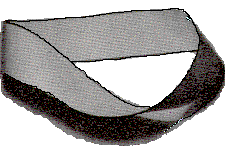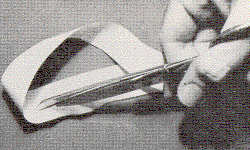![[picture of a simple paper loop]](mobloop.gif)
![[picture twisting the loop]](mobatt.gif)

![[picture of a simple paper loop]](mobloop.gif)
| ![[picture twisting the loop]](mobatt.gif)
| 
|
Check for yourself that it is one-sided by drawing a line down the middle of "one-side"—surprise!
What happens to the Möbius strip when it is cut in "half" lengthwise? Can you predict what happens when you cut it in quarters? Another variation is to cut the original Möbius strip in thirds!
![[picture drawing a line on a mobius strip]](mobdraw.gif)
| 
|
While on his western tour, Paul developed a deep mine and was extracting high quality ore. Our story begins when the mine was a horizontal shaft about a quarter of a mile back into the mountains and had a fairly high volume of ore coming out the wind- and Babe (the blue ox)-powered main conveyor belt four feet wide. The mine branched at that point, but the best ore was found straight ahead and the mine shaft had developed such that a longer but narrower conveyor belt would increase efficiency. Specifically it was decided that a conveyor belt twice as long and half as wide as the original would be the best solution. Paul got out his sharp ax and proceeded to slice the conveyor belt down the middle. When he finished they installed the new converyor belt without having to cut it anymore or even splice it, much to everyone's surprise. Paul explained that he had put the half twist in it so it would wear evenly on both sides.
A few years went by. Mining operations continued. Although the best ore vein curved slightly and narrowed down, they could still improve operations with a narrower, but longer conveyor. As Paul got out his new chain saw, he sent his trusty assistant to town to get a couple splicing kits. His assistant bulked having seen the results of the prior modification. He went anyway and was surprised when he came back to find the kits were not only needed, but the two resulting rings were linked together.
![[klein bottle recycling center joke]](klein.gif)
|
| BACK to the LESSON | HOMEWORK | NEXT LESSON |